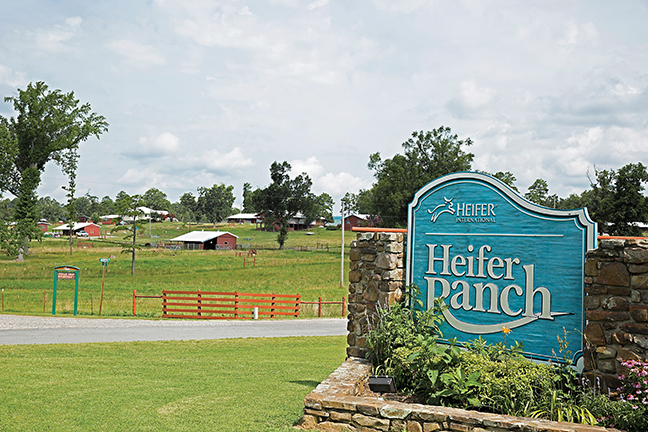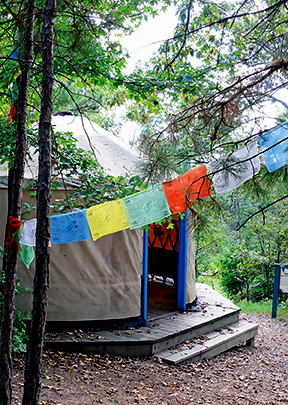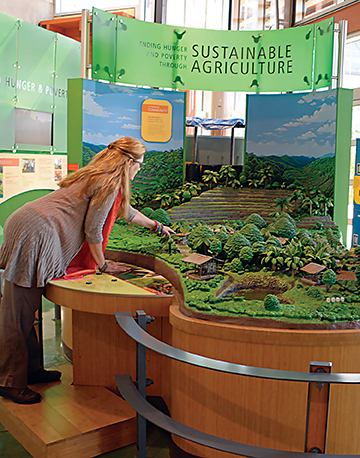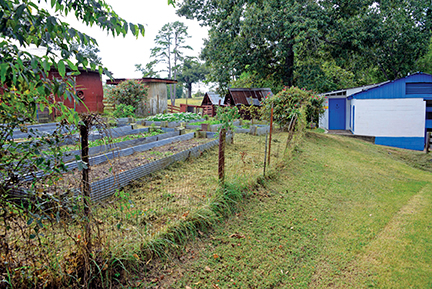Goats, Cows, Camels & Ending World Hunger
Posted on December 1, 2015 by bob in Travel
(Editor’s Note: Heifer International is a nonprofit organization whose mission is to end hunger and offer a means of self-reliance to the world’s poor. The humanitarian group, based in Little Rock, AR, currently provides livestock, trees, seeds and training in environmentally sound agriculture to families in 30 countries, including the United States.)

The Heifer Ranch covers 1,200 acres, 200 acres for educational purposes and 1,000 used in other ways
that help the foundation. (photo courtesy Heifer Ranch)
by Andrea Gross; photos by Irv Green (unless otherwise noted)
I trudge up steps made of mud and tires, duck under a string of multi-colored prayer flags and enter a round structure with a peaked roof. “You’re in Tibet,” says the guide.
Well, sort of. But this Tibet is in central Arkansas rather than central Asia, part of the Global Village

Replica of the home of a nomadic Tibetan family.
at Heifer Ranch, which in turn is part of an extraordinary program that depicts areas of the world rarely seen by tourists. This Tibet is not one of monks and monasteries, gilded statues and golden Buddhas. Rather it’s the Tibet of oft-forgotten communities, the Tibet of the poor.
My husband and I like to travel for many reasons, but our primary goal is to learn and understand how people live today. Thus, for us, Heifer Ranch – 45 miles northwest of Little Rock – is a grand travel opportunity, a chance to see the world without a passport.
Heifer International
Heifer International got its start in the 1930s when an Indiana aide worker named Dan West realized that starving children needed more than small handouts of rationed food. “These children don’t need a cup of milk; they need a cow,” he said.
To test his theory, he sent heifers to underprivileged families in Puerto Rico with the understanding that the recipients would give the animals’ female offspring to neighbors, who in turn would pass on that cow’s offspring to yet other families. Eventually, the majority of the villagers owned livestock, and the community became self-sufficient.
As the project expanded, West began raising animals on a ranch in the United States and distributing them to needy families abroad, but soon the cost became prohibitive. Today the Arkansas ranch property is used for educational and inspirational purposes.
In this way, “passing on the gift” has come to mean more than passing on the gift of an animal; it also means passing on the gift of awareness. As visitors to The Ranch become more aware of conditions in poor communities, they share their knowledge, resources and skills to help Heifer attain its goal, which is to do no less than end hunger and poverty around the world.
It’s a noble plan, one that seems particularly apropos now, in the midst of the holiday season. We’re driving to the Visitor Center, the radio tuned to a station that’s playing Christmas songs, when we suddenly spot a camel resting peacefully in a wooden shelter. A camel in Arkansas? It seems that miracles abound at Heifer. All that’s missing is two more camels and three wise men.

Hands-on museum explains Heifer’s program and philosophy.
An Educational Farm
Today the main purpose of Heifer Ranch is as a Learning Center. The Ranch only provides formal tours for large groups, but staff and volunteers do their best to accommodate individuals. We’re in luck. A recent retiree who’s spending several months working at Heifer offers to zoom us around in a golf cart.
“Camels were used in our Tanzania project,” he explains. “Between the gift of a camel and Heifer-provided training in sustainable agriculture and animal husbandry, the villagers were able to raise their standard of living considerably. The Tanzanian project is a typical success story.”
Our first stop is the Tibetan House. While it’s made of canvas, a sign informs us that in the “real” Tibet, it would be made from yak hair and sheep’s wool. The design allows it to be collapsed as the family follows the yaks from one grazing ground to another.
We move on to see other parts of this recreated world: a Thai shack perched on stilts, a group of African huts with conical roofs, a ramshackle Appalachian cabin, a generic urban warehouse cobbled together from scrap metal, and a dilapidated school bus that once served as a home for a family in the Mississippi delta.
Finally we stop at a “Guatemalan” farm consisting of a small cinderblock house, a raised garden bed

A re-created Guatemalan farm shows how, with the help of Heifer, an impoverished community can begin to lift itself out of poverty.
and, thanks to solar panels, electricity at night. It’s almost luxurious compared to the other homes.
These structures are used in Heifer’s extensive program of experiential workshops, during which organized groups spend anywhere from a few hours to several days getting a glimpse what it’s like to live in poverty. They milk goats, gather eggs, care for pigs, till the fields and tend to vegetable gardens. If they stay in the Guatemalan house, they may make tortillas; if they’re assigned to the African hut, they may make bricks with primitive tools. During the spring lambing program, women may even help deliver lambs.
Participants in all Heifer programs invariably say it’s a life-changing experience, one that opens their eyes as well as their hearts. It enables them to see the world and at the same time pass on the gift — be it the gift of a goat to an impoverished village, a basket made by an artisan in a developing country, or simply the gift of spreading the word.
This is travel – and Christmas – at its best.
For more on Heifer’s programs and gift-giving opportunities, see www.heifer.org. To read more information on other exciting destinations, visit www.traveltizers.com.









